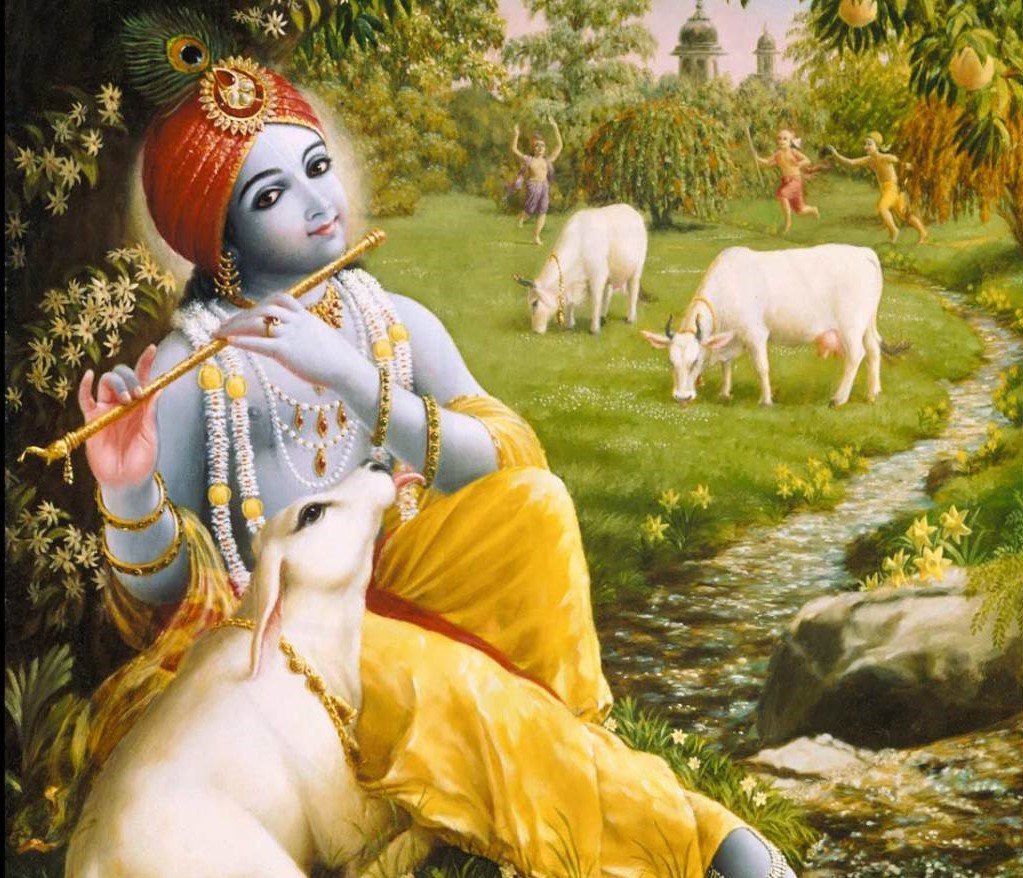OUR PHILOSOPHY
PRABHUADA TEACHINGS
A. C. Bhaktivedanta Swami Prabhupada, founder-acarya of the International Society for Krishna Consciousness, was born in 1896, in Calcutta, in a Vaisnava family.Srila Prabhupada was an extraordinary author, teacher, and saint.
SRILA PRABHUPADA SAYS… Two Lords, Nityananda Prabhu and Sri Chaitanya Mahaprabhu; they have appeared just to reclaim the fallen souls of this age. They are more kind then Krishna. Krishna, He is also very kind. He comes to deliver. But Krishna demands that first of all surrender. Chaitanya Mahaprabhu even does not demand surrender. He is so kind. (Voice choking) So take shelter of Sri Chaitanya Mahaprabhu and be happy. Thank you very much.
He managed to spread Krishna Consciousness all over the world, through his writing and preaching. His writings comprise of many volumes and are the basis of Krishna consciousness not only for his disciples but for his grand-disciples, affiliated members of the disciplic succession, and for the public at large
His works include Bhagavad-Gita as It is, the multi-volume Srimad-Bhagavatam, the multivolume Caitanya-caritamrta, The Nectar of Devotion, Krsna: The Supreme Personality of Godhead, Teachings of Lord Caitanya, Teachings of Lord Kapila, Teachings of Queen Kunti, Sri Isopanisad, The Nectar of Instruction, and dozens of small books.
Of all his various contributions, Srila Prabhupada considered his books most important. In fact, he would often describe his work of translating and explaining the ancient Vedic texts as his very life and soul. In 1970, Srila Prabhupada founded the Bhaktivedanta Book Trust, now the world’s largest publisher of Vedic literature. Through its work over the last three and a half decades, millions of people have read at least one of Srila Prabhupada’s books and have felt their lives genuinely enriched. Here is a brief introduction to the spiritual knowledge you will find within those books.
Srila Prabhupada’s Books-
1. Highlight the Importance of the Human Form of Life
2. Reveal the Perfect Knowledge of the Vedas
3. Present a Universal Science of God-Realization
4. Explain the Difference Between the Self and the Body
5. Easy Journey to Other Planets
6. Perfect Questions, Perfect Answers
7. The Science of Self-Realization
8. The Path of Perfection
9. Search for Liberation
10. The Journey of Self-Discovery
11. Message of Godhead

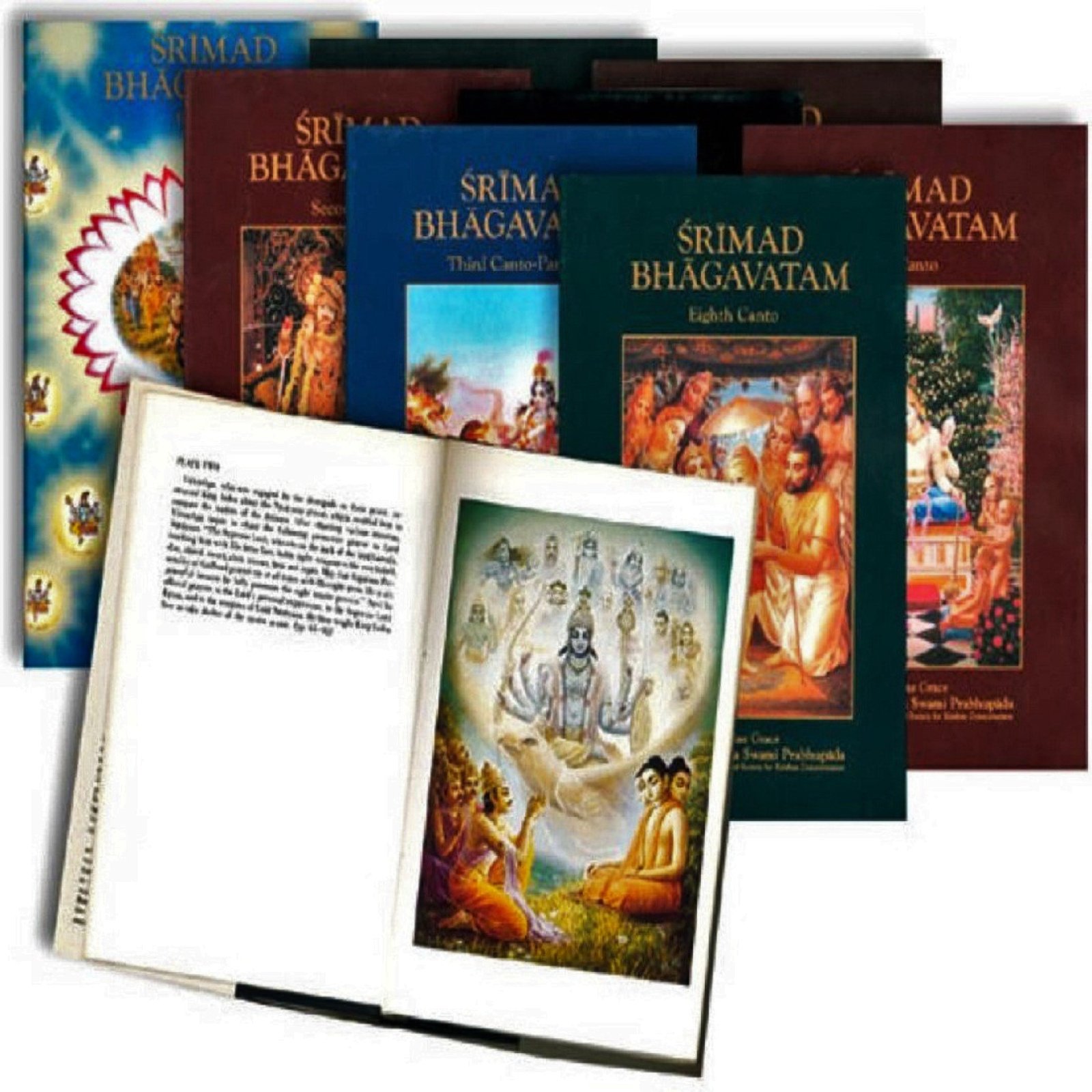
The Bhagavad-gita is universally renowned as the jewel of India’s spiritual wisdom. Spoken by Lord Krishna, the Supreme Personality of Godhead to His intimate disciple Arjuna, the Gita’s seven hundred concise verses provide a definitive guide to the science of self realization. No other philosophical or religious work reveals, in such a lucid and profound way, the nature of consciousness, the self, the universe and the Supreme.
His works include Bhagavad-Gita as It is, the multi-volume Srimad-Bhagavatam, the multivolume Caitanya-caritamrta, The Nectar of Devotion, Krsna: The Supreme Personality of Godhead, Teachings of Lord Caitanya, Teachings of Lord Kapila, Teachings of Queen Kunti, Sri Isopanisad, The Nectar of Instruction, and dozens of small books.
His Divine Grace A.C. Bhaktivedanta Swami Prabhupada is uniquely qualified to present this English translation and commentary on Bhagavad-gita. He is the world’s foremost Vedic scholar and teacher, and he is also the current representative of an unbroken chain of fully self-realized spiritual masters begining with Lord Krishna Himself.
His works include Bhagavad-Gita as It is, the multi-volume Srimad-Bhagavatam, the multivolume Caitanya-caritamrta, The Nectar of Devotion, Krsna: The Supreme Personality of Godhead, Teachings of Lord Caitanya, Teachings of Lord Kapila, Teachings of Queen Kunti, Sri Isopanisad, The Nectar of Instruction, and dozens of small books
His Divine Grace A.C. Bhaktivedanta Swami Prabhupada is uniquely qualified to present this English translation and commentary on Bhagavad-gita. He is the world’s foremost Vedic scholar and teacher, and he is also the current representative of an unbroken chain of fully self-realized spiritual masters begining with Lord Krishna Himself.
Thus, unlike other editions of the Gita, this one is presented as it is–without the slightest taint of adulteration or personal motivation. This edition is certain to stimulate and enlighten with its ancient yet thoroughly timely message.
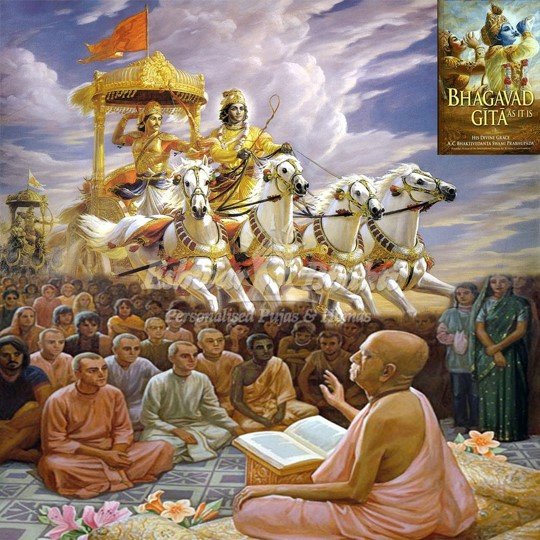
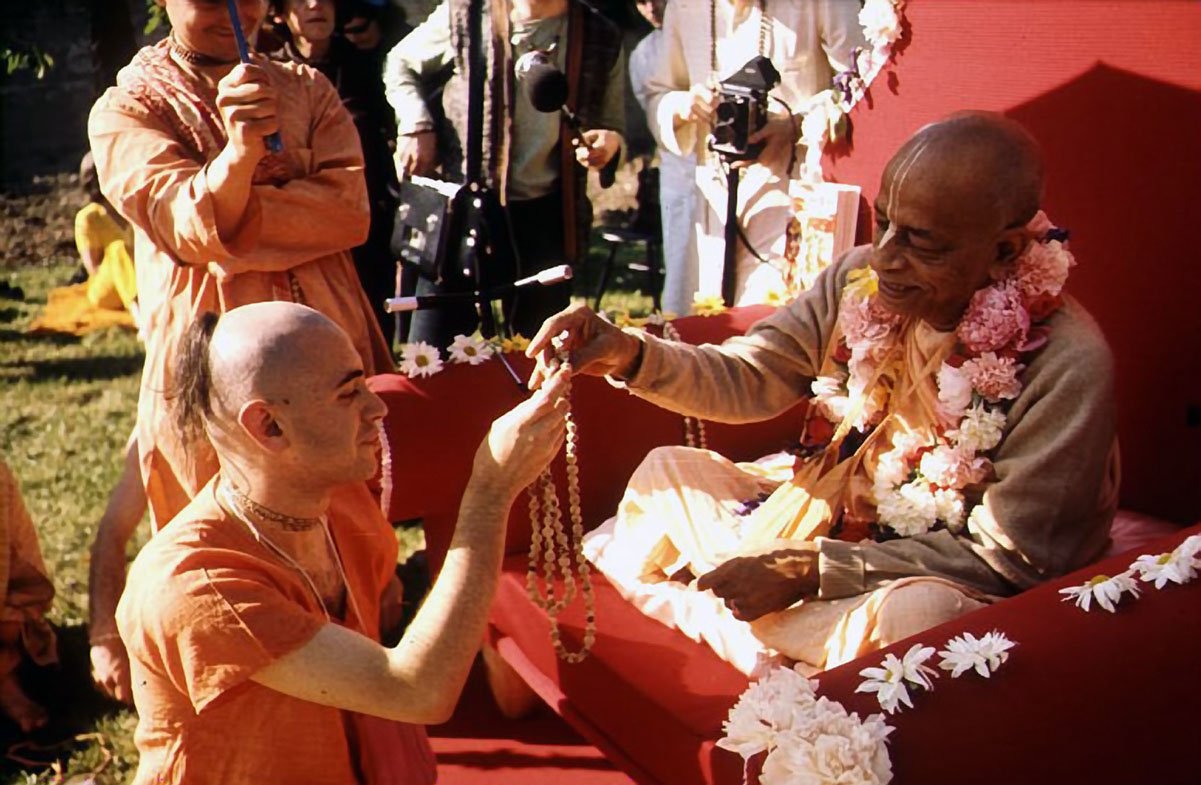
The International Society for Krishna Consciousness (ISKCON) was incorporated in New York in 1966. However, it is not a new religion. Its founder, His Divine Grace A. C. Bhaktivedanta Swami Prabhupada, represents a tradition tracing back to Chaitanya Mahaprabhu in the fifteenth and sixteenth centuries. And Chaitanya Himself appeared in a succession of teachers dating back thousands of years in India. This lineage, called the Brahma-Madhva Gaudiya sampradaya, is one of the four principle traditions of Vaishnavas, those who worship Lord Krishna or Lord Vishnu as supreme.
Key figures in the tradition Chaitanya Mahaprabhu is considered to be an incarnation of Lord Krishna and his consort Radharani themselves. He was born in Bengal in 1486. He taught the chanting of the Hare Krishna mantra while travelling for six years throughout India and He spent His final eighteen years in Jagannatha-puri. There he displayed the sublime emotions of one absorbed in love of God.
Chaitanya’s immediate followers, the Six Goswamis (Rupa, Sanatan, Jiva, Gopal Bhatta, Raghunath Bhatta and Raghunath das) drew on Vedic evidence to consolidate and document His teachings.
Srila Bhaktivinode Thakur (1838-1914) was a highly influential figure, and he re-established the moral and philosophical integrity of the tradition. Srila Bhaktisiddhanta Sarawati was the son of Bhaktivinode and the disciple of Gaura Kishor Babaji. He was a life-long celibate and a brilliant scholar. He established sixty-four centres throughout India and requested his disciples to spread the message of Chaitanya worldwide in the English language.
A. C. Bhaktivedanta Swami Prabhupada took initiation from Bhaktisiddhanta Sarasvati in 1926. As a married man he tried to execute the desire of his spiritual teacher to preach the message of Chaitanya through the world. He took sannyasa (vows of renunciation) in 1957. In 1965 he sailed for New York and established ISKCON the following year. In eleven years, he spread Krishna consciousness
There are two principles of Hare Krishna philosophy which are expressed practically by the practice of vegetarianism. These two principles are:
Non-violence
Non-violence means not to stop the progressive life (materially or spiritually) of any living being. According to the laws of karma and reincarnation if an animal is killed before its allotted time in that particular body has ended then it has to take birth again in the same type of body in order to complete its remaining days and be promoted upwards to the next species. Thus its evolution upwards through the different species of life is checked. Therefore, the killing of animals simply to satisfy the demands of the palate is an act of both material and spiritual violence.
Service to God (Krishna)
As far as service to God is concerned in Bhagavad-Gita it is said: “If one offers me (Krishna) with love and devotion a leaf, a flower, a fruit or water, I will accept it.Before eating anything devotees of Krishna perform a ceremony whereby they offer their food to God Because in the Bhagavad-Gita, Krishna says that he will only accept food if it is vegetarian then Hare Krishna’s only eat vegetarian food. This they do as an act of service to please God (Krishna).
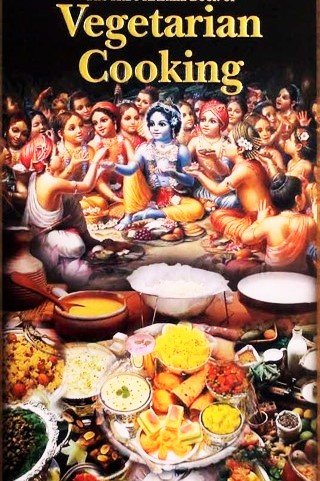
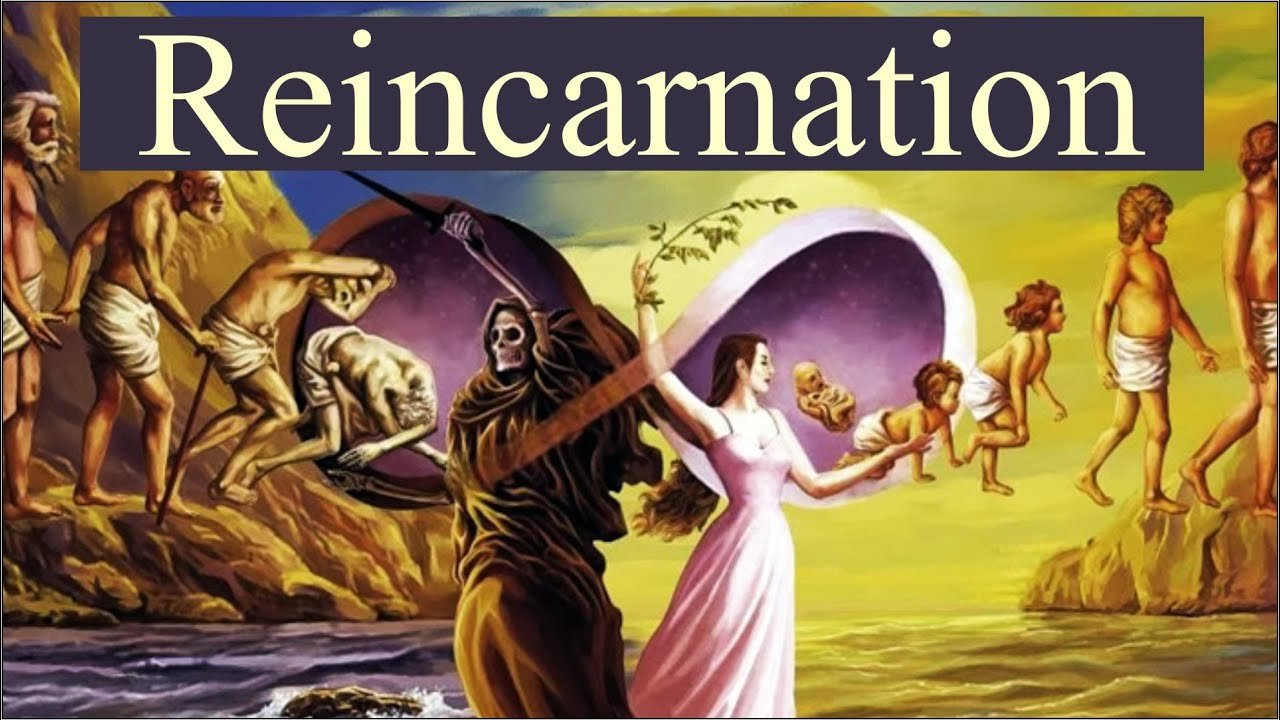
Reincarnation is the process by which the spiritual essence of any individual (commonly called “the soul”) passes from one body to another in a repeated cycle of birth and death.In the Bhagavad-Gita this process is explained using the following analogy:
“As the embodied soul passes, in this body, from boyhood to youth to old age, the soul similarly passes into another body at death. A sober person is not bewildered by such a change.”- (Bhagavad-Gita 2.13)
Because the soul eternally exists then this process, if unchecked, is also eternal. In everyday life there is always some degree of distress and suffering & because the soul is eternal, as long as he is in the cycle of reincarnation, then he will be eternally suffering. The Hare Krishna philosophy explains how one can break this cycle of repeated suffering. This is exemplified in the Bhagavad-Gita which, in essence, is an explanation of how to break this cycle and achieve liberation.
Mantra meditation is a spiritual and religious practice that has a place in practically all religious traditions, although the method of practice may differ. In the Vaishnava tradition (which includes the devotees of Krishna) this type of meditation has two basic forms. The first is individual practice and the second is congregational.
Individually devotees of Krishna perform a daily schedule of personal prayer and meditation. This is centred around the recitation of the names of Krishna (God) using prayer beads to count out the number of names chanted. The prayer, or “mantra”, that they repeat is called the Hare Krishna Maha Mantra:
“Hare Krishna, Hare Krishna, Krishna Krishna, Hare Hare, Hare Rama, Hare Rama, Rama Rama, Hare Hare”
The second form of this process, which is congregational, includes the use of musical instruments. Instead of chanting on beads the mantra is sung. “Hare”, “Krishna” and “Rama” are all names used in the Vaishnava tradition that refer to God and His energies. Because God is spiritual and all-powerful if someone chants his name then they will become purified – materially and spiritually.
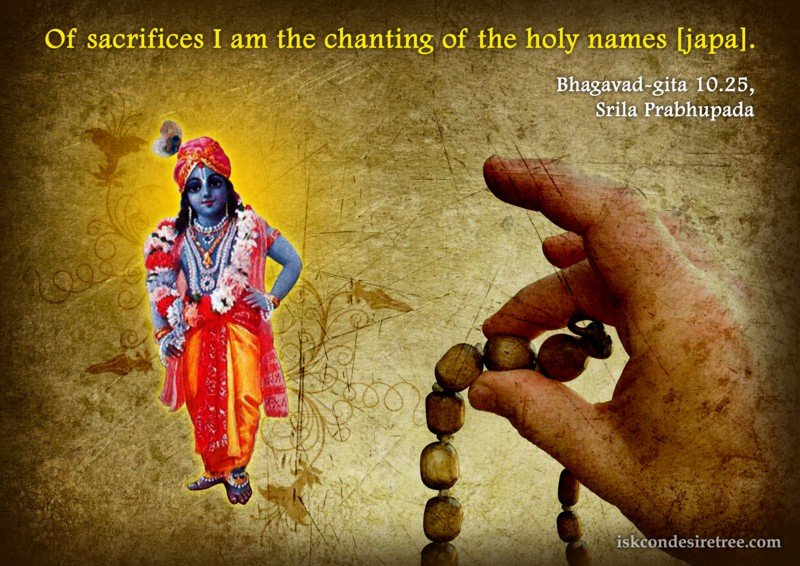

Yoga means to link oneself with God (Krishna) by concentrating the mind on him and controlling the ever-disturbing senses. By the practice of yoga one gradually becomes free from materialistic attachments. This is the primary characteristic of the yoga process. When one is free of materialistic attachments one loses interest in the body and becomes interested in spiritual perfection.
Yoga includes different practices depending on one’s level of spiritual advancement, and can be compared to a ladder for attaining the topmost spiritual realization. The complete ladder is called yoga and may be divided into 3 main parts. 1) Karma, 2) Jnana, and 3) Bhakti.
Karma-yoga
When a person knows the goal of life is Krishna (God), but is attached to working to get material comforts, and then he is acting in karma-yoga.
Jnana-yoga
When he knows the goal is Krishna, but takes pleasure in mental speculation, he is acting in jnana-yoga
Bhakti-yoga
When he knows the goal is Krishna and is not attached to any material thing, either gross or subtle, but simply desires to work for the pleasure of Krishna, then he is acting in bhakti-yoga. This is the highest perfection of the yoga system.
To make yoga practice really successful it requires self restraint (see Principles). The yoga process that the devotees of Krishna practice and endeavour to perfect is in the line of bhakti-yoga.In the Bhagavad-Gita Lord Krishna describes the process of yoga in Krishna consciousness:
“Always chanting my glories, endeavoring with great determination, bowing down before Me, these great souls perpetually worship Me with devotion.” – (Bhagavad-Gita 9.14)
“Karma” means “activity”, and the law of karma is the law that regulates the reactions to our activities. The law of karma is the natural law of action and reaction. In physics this is expressed by Newton’s law, “For every action there is an equal and opposite reaction”. Or, in Christian theology, “As ye sow so ye shall ye reap”.From a practical point of view this means that good actions give good results and bad or destructive actions give bad or less fortunate results.
It should be noted here that all souls are essentially good. This means that just because someone gets a bad reaction it does not mean that they are a bad person. Another important point is that karma is temporary. This means that although we may be experiencing a particular set of circumstances right now those circumstances will change in the future. This could happen in this life or even future lives. Not only is karma temporary it is also possible to change one’s karma, or even get rid of it altogether by acting spiritually in the service of God.Good reactions include things like wealth, beauty, intelligence and happiness. Bad reactions include things like poverty and disease.
Karma (good or bad) creates a continuous cycle by which one is entangled in repeated actions and subsequent reactions. As long as one is in this cycle one will naturally experience both happiness and distress. The philosophy of the devotees of Krishna teaches how to break this cycle and achieve a state of eternal happiness known as liberation in a pure relationship with Krishna (God).
From the spiritual point of view, that of eternity, it doesn’t really matter if one has “good” or “bad Karma. This is because past material karma does not impede one from making spiritual advancement.
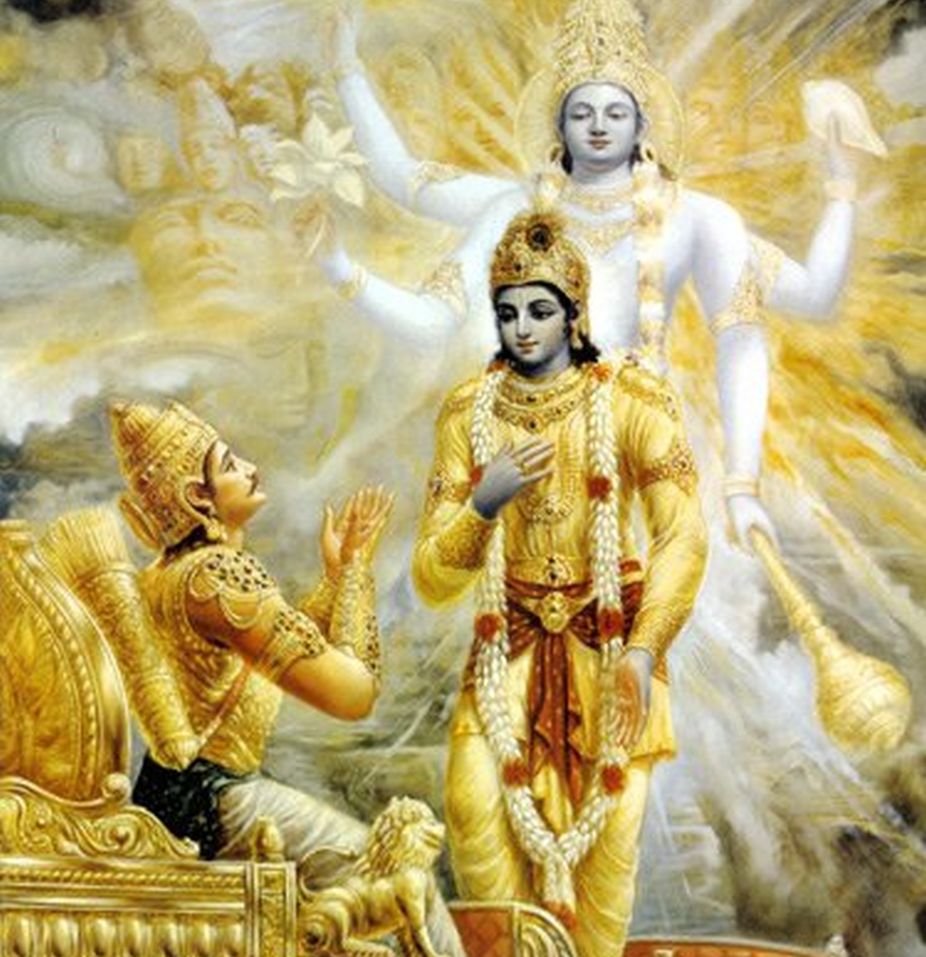
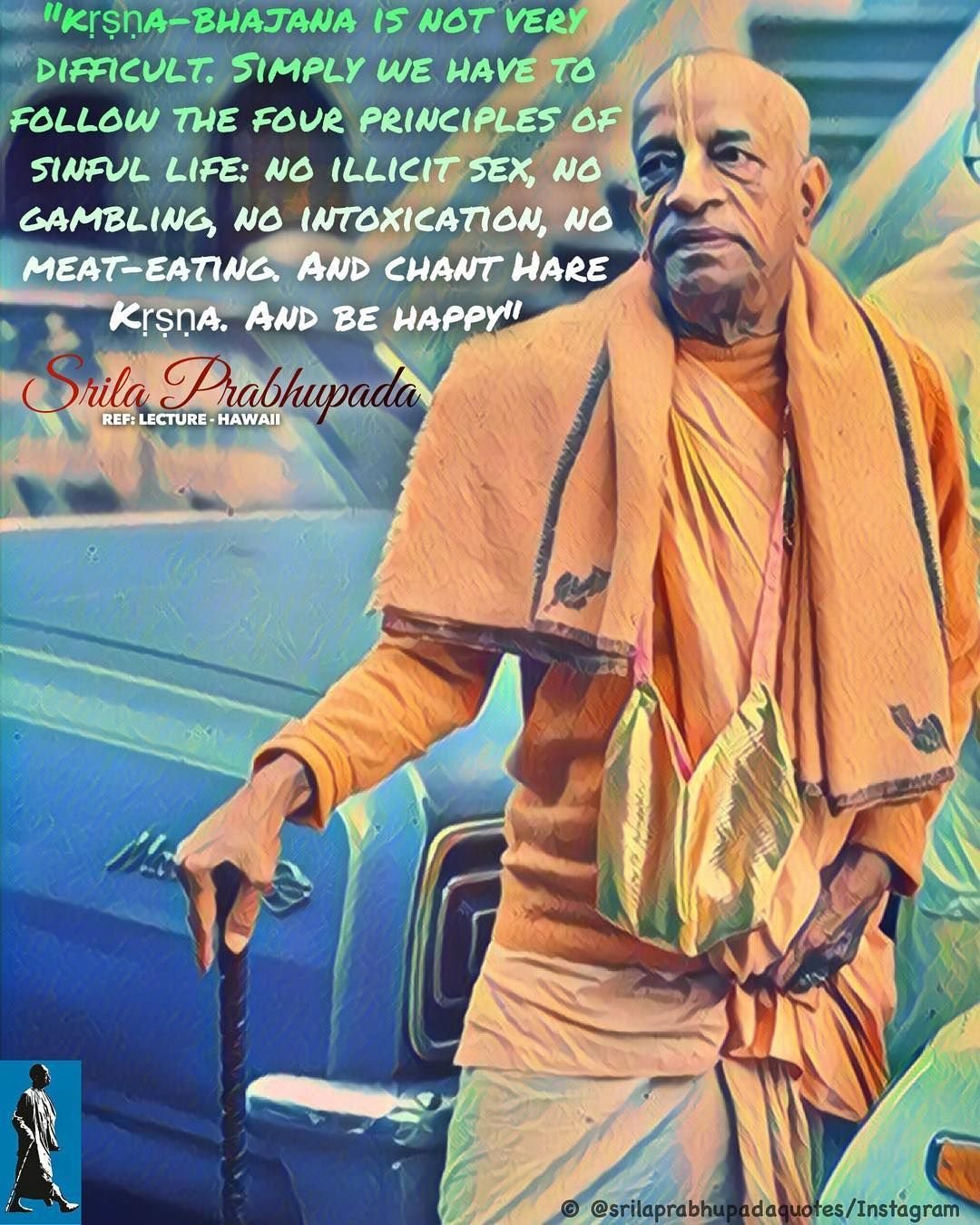
Hare Krishna devotees often say that religion without philosophy is sentimental and philosophy without religion is dry speculation. Religion expresses itself through culture: different codes of behavior that help us to become aware that we are not this temporary material body but an eternal spirit soul, servant of God.The four basic principles are as follows:
Cleanliness
Cleanliness Of body, mind and soul. This means the daily washing of the body, but also refraining from illicit sex (only sex for procreation within marriage). Celibacy, recitation of God´s (Krishna´s) holy names and studying the holy Scriptures help us to keep the mind and soul clean and balanced .
Mercy
To help living entities (materially as well as spiritually). True followers of the Vedic (or any other) Scriptures are strictly vegetarians. It is perfectly possible to live healthily and happily without needlessly killing innocent animals. To kill our fellow living entities instead of protecting them, is against the laws of God.
Austerity
To take only what we really need, without greed or violence. Intoxications like alcohol, hard and soft drugs, tobacco, caffeine etc. make someones mercy and friendliness disappear. Addictions are not only unnecessary, but also very harmful (to body, mind and to others). The best alternative for addictions is an awakening of our eternal relationship with God (Krishna) by living in accordance with His laws.
Truthfulness
Means that we should not lie or gamble. Gambling destroys truthfulness because it is an attempt to bypass the laws of nature and obtain material profit without honestly working for them. An honest deed is the best gamble in the world and a sure winner.There are many rules and regulations to follow in human life which help us to be healthy, happy and successful. The most important of all is: Always remember Krishna (God) and never forget Him.
“Holy Cow!” We’ve all heard that expletive enough times, but what on earth is holy about a cow? To find that out, we need to go to India.
In the Indian villager’s agrarian lifestyle, conserving natural resources is an integral part of daily existence. He uses nature’s gifts directly to manufacture all his necessities, from his mud hut dwelling to his home-spun clothes. But the most important feature of village conservation is protecting cows. Each homestead keeps at least one cow, and the animal is considered the most useful of all domestic beasts. In fact both cow and bull are seen as indispensable in rural India, in other words to 90% of the country’s population. Eating only grass, which costs nothing to produce, the cow in turn produces milk that provides nearly all the nutrients we need. One cow produces more milk than a whole family can drink in one day. What is not drunk is turned into yoghurt, cheese, butter and ghee (butterfat) – the latter being the basis for so many exquisite Indian sweetmeats and savouries.
Because cows supply milk, in Indian culture they are accepted as our mother, and therefore worthy of reverence.In India it is well known that even the stool of the cow has antiseptic properties. Furthermore, in any Indian village you will see cow pats drying in the sun, ready to be used as fuel for cooking. Cow urine is prescribed in Ayurveda as a medicine, and when the cow finally dies she gives her skin for shoes and bags, and her horns for other implements.
The majestic bull can be seen in Indian fields, pulling the plough. Slower than tractors, but he does not compact the soil and reduce its productivity like other mechanical methods. Nor does such ploughing kill so many earth dwelling creatures. And of course, the more we use machinery in the place of working animals like the ox, then the more we become encumbered with the need for so many subsidiary industries to make and maintain those machines.
The bull is still used throughout rural India, and he is therefore seen as a father, working hard to produce man’s food. And as a father he too is considered worthy of reverence. There is a symbiotic relationship between men and cows. If we take good care of them, ensuring they are sheltered, fed and protected, they happily produce more than enough milk for their calves, and we can take the excess without harming them in any way.
The Krishna consciousness movement is developing farming communities around the world. At New Vrindaban there are cows. The results of the gentle Vedic method are evident there, where the cows peacefully produce first class milk.
